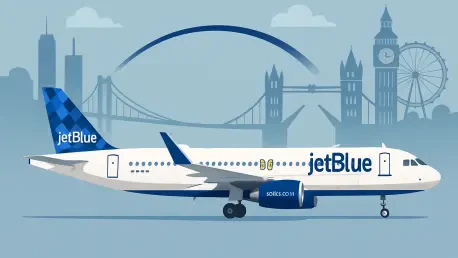In the competitive arena of transatlantic travel, a striking statistic emerges: low-cost carriers have captured nearly 15% of the market share on leisure routes between the U.S. and Europe over the past few years, a figure that continues to climb. This trend underscores a seismic shift in how travelers prioritize affordability alongside quality, creating fertile ground for airlines like JetBlue to redefine long-haul journeys. The recent announcement of summer seasonal flights from Boston Logan International Airport to Barcelona, Spain, and Milan, Italy, starting in 2026, positions JetBlue as a pivotal player in this evolving landscape, particularly for New England travelers seeking diverse European connections.
This market analysis aims to dissect the implications of JetBlue’s strategic expansion, focusing on how these new routes reflect broader industry dynamics and consumer preferences. By examining current patterns, competitive positioning, and future projections, the goal is to uncover what this move means for stakeholders ranging from passengers to rival carriers. The importance of such an analysis lies in understanding how low-cost models are disrupting traditional transatlantic paradigms, potentially reshaping pricing structures and service expectations.
Readers can anticipate a deep dive into the data-driven trends fueling JetBlue’s growth, alongside forecasts that highlight challenges and opportunities in the coming years. This exploration will not only illuminate the airline’s calculated push into Southern Europe but also provide a lens through which to view the broader transformation of international leisure travel. As the industry stands at a crossroads, JetBlue’s latest maneuver offers a compelling case study in innovation and market adaptation.
Unpacking Market Trends and Strategic Insights
Transatlantic Growth: Low-Cost Carriers Redefine the Game
The transatlantic market has witnessed a notable pivot over recent years, with low-cost carriers steadily encroaching on a space long dominated by legacy airlines such as Delta and British Airways. JetBlue, a prominent American low-cost airline, exemplifies this shift, having expanded its European network from Boston to include nine daily summer nonstop flights by 2026. This growth trajectory, which includes new routes to Barcelona’s Josep Tarradellas Barcelona-El Prat Airport starting April 16, 2026, and Milan’s Malpensa Airport starting May 11, 2026, reflects a deliberate strategy to target high-demand leisure destinations.
Data from industry reports indicate that leisure travel demand between the U.S. and Europe has surged by approximately 20% since 2025, driven by a post-pandemic rebound and a growing appetite for cultural and vacation experiences. JetBlue’s focus on Boston as a key hub leverages the city’s robust traveler base, with Logan International Airport already serving 77 nonstop destinations. The airline’s expansion taps into this regional strength, positioning it to capture a significant share of New England’s outbound traffic to Southern Europe, a segment historically underserved by budget-friendly options.
However, the competitive landscape remains fierce, as established carriers often counter with loyalty programs and entrenched route networks. JetBlue’s challenge lies in differentiating itself through value-driven pricing and enhanced onboard experiences, a balancing act that could redefine consumer expectations if executed effectively. The broader trend suggests that low-cost carriers might account for up to 25% of transatlantic leisure traffic by the end of the decade, signaling a transformative era for cost-conscious travelers.
Route-Specific Analysis: Barcelona and Milan as Strategic Choices
Drilling down into the specifics of the new routes, JetBlue’s selection of Barcelona and Milan from Boston reveals a nuanced understanding of market dynamics and traveler demographics. Barcelona, a cultural epicenter with its blend of history and modernity, attracts millions of tourists annually, while Milan stands as a global hub for fashion and business, appealing to a mix of leisure and hybrid travelers. Launching daily summer seasonal flights to these cities aligns with peak travel periods, maximizing load factors and revenue potential during high-demand months.
Market data highlights that Boston-area travelers have shown a 30% increase in searches for Southern European destinations since 2025, reflecting untapped potential for direct connectivity. JetBlue’s entry into these markets, with bookings opening on November 20, 2024, positions it to capitalize on this trend ahead of competitors who may rely on connecting flights through larger European hubs. The risk of seasonal demand fluctuations persists, yet the airline’s tailored scheduling mitigates this by focusing on summer peaks, ensuring operational efficiency.
Comparatively, legacy carriers operating similar routes often charge premium fares, creating an opportunity for JetBlue to attract price-sensitive customers. The airline’s dual focus on leisure-heavy destinations like Barcelona alongside economically significant cities like Milan diversifies its appeal, potentially drawing a broad customer base. This strategic alignment with regional travel patterns underscores JetBlue’s intent to carve out a niche as a viable alternative in a crowded market.
Onboard Innovation as a Market Differentiator
A critical factor in JetBlue’s market positioning is its emphasis on elevating the passenger experience, a trend gaining traction among low-cost carriers seeking to compete with premium offerings. The A321 aircraft servicing the Barcelona and Milan routes will feature the airline’s Mint premium service, including lie-flat private suites and a restaurant-style menu inspired by New York’s culinary scene. Core cabin passengers, meanwhile, benefit from complimentary meals, free snacks, diverse entertainment options, and unlimited high-speed internet, amenities that rival those of traditional airlines at a lower cost.
Industry analysis suggests that customer satisfaction metrics for transatlantic flights increasingly hinge on in-flight comfort and connectivity, areas where JetBlue appears to excel. By offering such features without the hefty price tag associated with legacy carriers, the airline addresses a growing consumer demand for value without compromise. This approach could drive a loyalty shift among leisure travelers, particularly families and younger demographics who prioritize affordability alongside quality.
Yet, scaling these personalized services across an expanding network poses operational challenges, including maintaining consistency and managing costs. If successful, JetBlue’s model could set a benchmark for other low-cost carriers, potentially accelerating the adoption of hybrid service models in the transatlantic space. The market implication is clear: differentiation through onboard innovation is becoming a key battleground, with long-term impacts on competitive pricing and traveler expectations.
Future Projections: Opportunities and Headwinds
Looking toward the horizon, projections for the transatlantic market indicate sustained growth in leisure travel, with an estimated annual increase of 5-7% through 2030, fueled by economic recovery and evolving consumer behaviors. JetBlue’s expansion to nine European destinations from Boston by 2026 positions it to capture a portion of this growth, particularly in secondary markets like Barcelona and Milan, where direct low-cost options remain limited. Technological advancements, such as fuel-efficient aircraft, further support cost reductions that could keep fares competitive.
Economic variables, including fluctuating fuel prices and currency exchange rates, present potential headwinds that could impact profitability and pricing strategies. Additionally, regulatory shifts in international aviation agreements may influence route permissions and operational costs, requiring agility from airlines like JetBlue. Environmental pressures also loom large, with increasing scrutiny on carbon footprints pushing carriers to invest in sustainable practices, an area where JetBlue has already initiated efforts through fleet modernization.
Expert consensus points to a future where low-cost carriers could dominate up to 30% of transatlantic leisure routes by the late 2020s, provided they navigate these challenges effectively. JetBlue’s proactive route additions and customer-centric innovations suggest a strong foothold, but sustained success will depend on balancing expansion with operational stability. The market is poised for further disruption, with implications for pricing models, service standards, and regional connectivity.
Reflecting on Market Shifts and Strategic Pathways
Looking back, JetBlue’s strategic expansion into Barcelona and Milan from Boston marked a significant milestone in the transatlantic leisure market, highlighting the growing influence of low-cost carriers in a historically premium-dominated space. The airline’s focus on high-demand Southern European destinations, paired with innovative onboard offerings, demonstrated a keen alignment with evolving traveler preferences for value and comfort. This move also underscored the rising importance of regional hubs like Boston in shaping international travel patterns.
For stakeholders, the next steps involve leveraging these insights to refine strategies, whether through partnerships with travel agencies to bundle vacation packages or through competitive responses from rival carriers adjusting their own service models. Airlines and industry players need to prioritize adaptability, closely monitoring economic and regulatory developments to stay ahead of potential disruptions. Investing in sustainability initiatives emerges as a critical consideration, ensuring long-term viability amid growing environmental concerns.
Ultimately, the path forward requires a focus on data-driven decision-making to anticipate demand shifts and optimize route profitability. JetBlue’s journey offers a blueprint for blending affordability with quality, setting a precedent that others could follow. As the transatlantic market continues to evolve, the lessons from this expansion serve as a guide for navigating the delicate balance between growth ambitions and operational realities.









